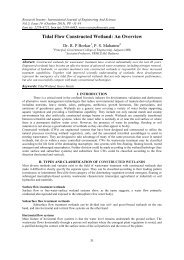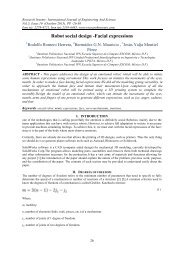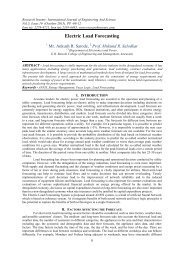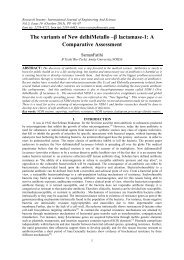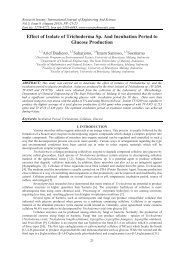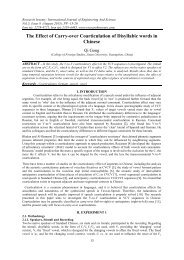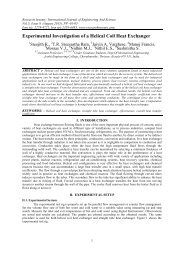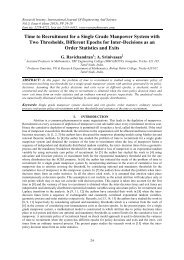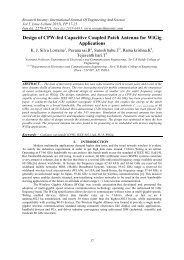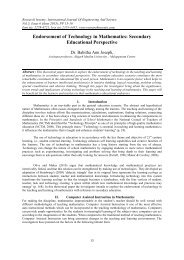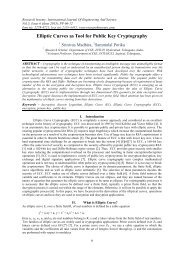A Study on Stabilization of Black Cotton Soil by Use of Fly Ash, Ferric Chloride and Stone Dust
Research Inventy : International Journal of Engineering and Science is published by the group of young academic and industrial researchers with 12 Issues per year. It is an online as well as print version open access journal that provides rapid publication (monthly) of articles in all areas of the subject such as: civil, mechanical, chemical, electronic and computer engineering as well as production and information technology. The Journal welcomes the submission of manuscripts that meet the general criteria of significance and scientific excellence. Papers will be published by rapid process within 20 days after acceptance and peer review process takes only 7 days. All articles published in Research Inventy will be peer-reviewed.
Research Inventy : International Journal of Engineering and Science is published by the group of young academic and industrial researchers with 12 Issues per year. It is an online as well as print version open access journal that provides rapid publication (monthly) of articles in all areas of the subject such as: civil, mechanical, chemical, electronic and computer engineering as well as production and information technology. The Journal welcomes the submission of manuscripts that meet the general criteria of significance and scientific excellence. Papers will be published by rapid process within 20 days after acceptance and peer review process takes only 7 days. All articles published in Research Inventy will be peer-reviewed.
You also want an ePaper? Increase the reach of your titles
YUMPU automatically turns print PDFs into web optimized ePapers that Google loves.
Research Inventy: Internati<strong>on</strong>al Journal <strong>of</strong> Engineering And Science<br />
Vol.5, Issue 10 (October 2015), PP -20-25<br />
Issn (e): 2278-4721, Issn (p):2319-6483, www.researchinventy.com<br />
A <str<strong>on</strong>g>Study</str<strong>on</strong>g> <strong>on</strong> Stabilizati<strong>on</strong> <strong>of</strong> <strong>Black</strong> Cott<strong>on</strong> <strong>Soil</strong> <strong>by</strong> <strong>Use</strong> <strong>of</strong> <strong>Fly</strong> <strong>Ash</strong>,<br />
<strong>Ferric</strong> <strong>Chloride</strong> <strong>and</strong> St<strong>on</strong>e <strong>Dust</strong><br />
1 Brajesh Mishra, 2 Ravi Shanker Mishra<br />
1 M. Tech., Assistant Engineer, U.P. Cane Development Department, Lucknow, India<br />
2 (Pr<strong>of</strong>essor &Head, Department <strong>of</strong> Civil Engineering, AIM T , Lucknow, India<br />
ABSTRACT - <strong>Black</strong> cott<strong>on</strong> soil is susceptible to detrimental volume changes due to variati<strong>on</strong> in moisture<br />
c<strong>on</strong>tent. A clay mineral named M<strong>on</strong>tomorill<strong>on</strong>ite which has exp<strong>and</strong>ing lattice is resp<strong>on</strong>sible to such behavior <strong>of</strong><br />
this soil. Because <strong>of</strong> its special structure <strong>and</strong> properties it is subjected to appreciable volume changes. These<br />
soils are covering a large area approximately around 20% <strong>of</strong> l<strong>and</strong> in India. It is due to its extensive area<br />
sometimes it becomes impossible to alter the highway alignment to avoid this type <strong>of</strong> soil. In recent past years<br />
various methods <strong>of</strong> stabilizing these type <strong>of</strong> soils have been used with varied degree <strong>of</strong> results. Some <strong>of</strong> the<br />
comm<strong>on</strong> methods like lime stabilizati<strong>on</strong>, soil replacement, moisture c<strong>on</strong>trol <strong>and</strong>, prewetting have been used. The<br />
research is still going <strong>on</strong> to find out suitable <strong>and</strong> perfect soluti<strong>on</strong> for the treatment <strong>of</strong> black cott<strong>on</strong> soil.<br />
According to recent research str<strong>on</strong>g electrolytes can be used in place <strong>of</strong> lime due to their dissolving nature in<br />
water <strong>and</strong> readiness for adequate cati<strong>on</strong> exchange .In the present research work experimental investigati<strong>on</strong>s<br />
were carried out <strong>by</strong> using fly ash, st<strong>on</strong>e dust <strong>and</strong> ferric chloride to improve the properties <strong>of</strong> black cott<strong>on</strong> soil.<br />
Keywords- <strong>Fly</strong> ash, st<strong>on</strong>e dust, ferric chloride, maximum dry density(M.D.D.),California Bearing<br />
Ratio(C.B.R.).<br />
I. INTRODUCTION<br />
<strong>Black</strong> cott<strong>on</strong> soils are <strong>on</strong>e <strong>of</strong> the most challenging soils for engineers because <strong>of</strong> their swelling <strong>and</strong><br />
shrinkage acti<strong>on</strong> due to variati<strong>on</strong> in moisture c<strong>on</strong>tent. When these soils come in c<strong>on</strong>tact with water volume<br />
increases <strong>and</strong> the volume decreases when water is removed. These soil cover approximately 20% area <strong>of</strong> l<strong>and</strong> in<br />
India. <strong>Black</strong> cott<strong>on</strong> soil are found in extensive regi<strong>on</strong> <strong>of</strong> Deccan Trap in Indian. They are <strong>of</strong> variable thickness,<br />
underlain <strong>by</strong> black sticky material known as “black soil”. <strong>Black</strong> cott<strong>on</strong> soil when comes in c<strong>on</strong>tact with water it<br />
either swells or shrinks <strong>and</strong> resulting in moments to the structure which are generally not related to direct effect<br />
<strong>of</strong> loading. On account <strong>of</strong> its high volumetric changes it is not suitable for c<strong>on</strong>structi<strong>on</strong>. It swells <strong>and</strong> shrinks<br />
excessively due to present <strong>of</strong> fine clay particles. Alternate swelling <strong>and</strong> shrinking <strong>of</strong> soil is resp<strong>on</strong>sible for<br />
differential settlement <strong>of</strong> structure so black cott<strong>on</strong> soil must be treated <strong>by</strong> using suitable admixtures to stabilize<br />
it. In my research work stabilizati<strong>on</strong> <strong>of</strong> black cott<strong>on</strong> soil is d<strong>on</strong>e <strong>by</strong> using lime as an admixture. The most<br />
comm<strong>on</strong> type <strong>of</strong> stabilizati<strong>on</strong> are listed below-<br />
Lime stabilizati<strong>on</strong><br />
Cement stabilizati<strong>on</strong><br />
Chemical stabilizati<strong>on</strong><br />
Bitumen stabilizati<strong>on</strong><br />
Salt stabilizati<strong>on</strong><br />
Many researchers have performed various investigati<strong>on</strong>s <strong>on</strong> characteristics <strong>of</strong> black cott<strong>on</strong> soil. Some <strong>of</strong> the<br />
prominent names are Erdal Cokca (2001), Dr. K.V. Manoj Krishna (2012), D. Koteswara Rao(2012), K. Ramu<br />
(2012), Prasada D.S.V.(2010), Katti R.K.(1966) <strong>and</strong> P.P. Sivapulliati<strong>on</strong> .<br />
20
A <str<strong>on</strong>g>Study</str<strong>on</strong>g> <strong>on</strong> Stabilizati<strong>on</strong> <strong>of</strong> <strong>Black</strong> Cott<strong>on</strong> <strong>Soil</strong> <strong>by</strong> <strong>Use</strong>…<br />
Fig-2: Map <strong>of</strong> India showing <strong>Black</strong> Cott<strong>on</strong> & other soils<br />
II. MATERIALS USED<br />
2.1. Samples Collecti<strong>on</strong>: To study the effect <strong>of</strong> fly ash, st<strong>on</strong>e dust <strong>and</strong> ferric chloride <strong>on</strong> black cott<strong>on</strong> soil the<br />
samples <strong>of</strong> black cott<strong>on</strong> soil were collected from some parts <strong>of</strong> Jhansi, a district in state <strong>of</strong> Uttar Pradesh in<br />
India, samples <strong>of</strong> st<strong>on</strong>e dust were collected from a Lalkuwan quarry near Haldwani district <strong>of</strong> Uttarakh<strong>and</strong> state<br />
in India <strong>and</strong> ferric chloride (FeCl3) <strong>of</strong> laboratory grade from local area <strong>of</strong> Lucknow in India. <strong>Fly</strong> ash from<br />
thermal power in Uttar Pradesh in India.<br />
2.1.1. Properties <strong>of</strong> <strong>Black</strong> Cott<strong>on</strong> <strong>Soil</strong>: The properties <strong>of</strong> black cott<strong>on</strong> soil are listed below-<br />
Table-1 Chemical Compositi<strong>on</strong> <strong>of</strong> <strong>Black</strong> Cott<strong>on</strong> soil<br />
S. No. Descripti<strong>on</strong> Range<br />
1 Silica (SiO2) 48- 58( %)<br />
2 Alumina (Al2O3) 13- 22( %)<br />
3 Lime (CaO) 1- 8( %)<br />
4 Magnesium Oxide (MgO) 1.8- 5( %)<br />
5 <strong>Ferric</strong> Oxide (Fe2O3) 7.5- 15( %)<br />
6 Sulphates (SO4) 0.9- 2.0( %)<br />
7 Carb<strong>on</strong>ates (CO3) 0.5- 6.6( %)<br />
8 Organic Matter 0.54 3.6( %)<br />
9 Loss <strong>on</strong> Igniti<strong>on</strong> 4.8- 16.5( %)<br />
10 pH 6.7- 8.9<br />
Table-2 Other properties <strong>of</strong> <strong>Black</strong> Cott<strong>on</strong> soil<br />
S. Descripti<strong>on</strong> <strong>of</strong> Properties Value<br />
No.<br />
1 Liquid Limit (%) 58<br />
2 Plastic Limit (%) 24<br />
3 Plasticity Index (%) 34<br />
4 Specific Gravity 2.51<br />
5 I.S. Classificati<strong>on</strong> CH<br />
6 Optimum Moisture C<strong>on</strong>tent(OMC) 23%<br />
7 Maximum Dry Density(MDD) g/cm³ 1.624<br />
8 California Bearing Ratio(CBR) 1.92%<br />
9 Free Swell Index 85<br />
Intended percentage <strong>of</strong> additi<strong>on</strong> <strong>of</strong> various materials are shown below-<br />
21
A <str<strong>on</strong>g>Study</str<strong>on</strong>g> <strong>on</strong> Stabilizati<strong>on</strong> <strong>of</strong> <strong>Black</strong> Cott<strong>on</strong> <strong>Soil</strong> <strong>by</strong> <strong>Use</strong>…<br />
2.1.2. <strong>Fly</strong> ash: <strong>Fly</strong> ash c<strong>on</strong>tent was varied from 0 to 15% <strong>by</strong> dry weight <strong>of</strong> soil with a increment <strong>of</strong> 3%.<br />
Table-3 Engineering properties <strong>of</strong> <strong>Fly</strong> ash<br />
Parameter<br />
Range<br />
Specific Gravity 1.90 – 2.55<br />
Plasticity<br />
N<strong>on</strong> plastic<br />
Maximum dry density (gm/cc) 0.9 – 1.6<br />
Optimum moisture c<strong>on</strong>tent (%) 38.0 – 18.0<br />
Cohesi<strong>on</strong> (KN/m 2 )<br />
Negligible<br />
Angle <strong>of</strong> internal fricti<strong>on</strong> (¢) 30 0 – 40 0<br />
Coefficient <strong>of</strong> c<strong>on</strong>solidati<strong>on</strong> C v (cm 2 /sec) 1.75 x 10 -5 – 2.01 x 10 -3<br />
Compressi<strong>on</strong> index C c 0.05 – 0.4<br />
Permeability (cm/sec) 8 x 10 -6 – 7 x 10 -4<br />
Particle size distributi<strong>on</strong> (% <strong>of</strong> materials)<br />
Clay size fracti<strong>on</strong><br />
Silt size fracti<strong>on</strong><br />
S<strong>and</strong> size fracti<strong>on</strong><br />
Gravel size fracti<strong>on</strong><br />
1 – 10<br />
8 – 85<br />
7 – 90<br />
0 – 10<br />
Coefficient <strong>of</strong> uniformity 3.1 – 10.7<br />
2.2.3. <strong>Ferric</strong> chloride (FeCl3): <strong>Ferric</strong> chloride (laboratory grade) c<strong>on</strong>tent was varied from 0 to 2.5% <strong>by</strong> dry<br />
weight <strong>of</strong> soil with a increment <strong>of</strong> 0.50%.<br />
2.2.4. St<strong>on</strong>e <strong>Dust</strong>: St<strong>on</strong>e dust c<strong>on</strong>tent was varied from 0 to 25% <strong>by</strong> dry weight <strong>of</strong> soil with a increment <strong>of</strong> 5%.<br />
Table-4 Physical properties <strong>of</strong> St<strong>on</strong>e dust<br />
S. Descripti<strong>on</strong> <strong>of</strong> Properties<br />
Value<br />
No.<br />
1 Liquid Limit (%) N<strong>on</strong> Plastic<br />
2 Plastic Limit (%) N<strong>on</strong> Plastic<br />
3 Specific Gravity 2.57<br />
4 Optimum Moisture C<strong>on</strong>tent(OMC) 7.3%<br />
5 Maximum Dry Density(MDD) g/cm³ 1.90<br />
6 Color Grey<br />
III. EXPERIMENTAL INVESTIGATIONS<br />
Test <strong>on</strong> virgin soil sample were carried out. Samples were prepared with additi<strong>on</strong> <strong>of</strong> fly ash, ferric chloride <strong>and</strong><br />
st<strong>on</strong>e dust in various porti<strong>on</strong>s <strong>and</strong> sufficient time was given for its stabilizati<strong>on</strong> <strong>and</strong> again various tests like<br />
Atterberg’s limits, compacti<strong>on</strong> parameters <strong>and</strong> C.B.R. were carried out. The various compositi<strong>on</strong> are as below-<br />
Samples<br />
Table-5 Showing different compositi<strong>on</strong>s <strong>of</strong> samples<br />
Compositi<strong>on</strong><br />
BC1<br />
BC2<br />
BC3<br />
BC4<br />
BC5<br />
BC6<br />
B.C. soil+0% FeCl3+0% <strong>Fly</strong> ash+ 0% St<strong>on</strong>e dust<br />
B.C. soil+0.5% FeCl3+3% <strong>Fly</strong> ash+ 5% St<strong>on</strong>e dust<br />
B.C. soil+1% FeCl3+6% <strong>Fly</strong> ash+ 10% St<strong>on</strong>e dust<br />
B.C. soil+1.5% FeCl3+9% <strong>Fly</strong> ash+ 15% St<strong>on</strong>e dust<br />
B.C. soil+2.0% FeCl3+12% <strong>Fly</strong> ash+ 20% St<strong>on</strong>e dust<br />
B.C. soil+2.5% FeCl3+15% <strong>Fly</strong> ash+ 25% St<strong>on</strong>e dust<br />
• Liquid Limit (L.L.): The liquid limit test was c<strong>on</strong>ducted as per guidelines <strong>of</strong> IS:2720-:IV-1970 <strong>on</strong><br />
treated <strong>and</strong> untreated black cott<strong>on</strong> soil samples.<br />
• Plastic Limit (P.L.): The plastic limit test was c<strong>on</strong>ducted as per guidelines <strong>of</strong> IS:2720-:IV-1970 <strong>on</strong><br />
treated <strong>and</strong> untreated black cott<strong>on</strong> soil samples.<br />
• O.M.C. <strong>and</strong> Maximum dry density: This test was c<strong>on</strong>ducted as per guidelines <strong>of</strong> IS:2720-:VI-1974<br />
<strong>on</strong> treated <strong>and</strong> untreated black cott<strong>on</strong> soil samples.<br />
22
A <str<strong>on</strong>g>Study</str<strong>on</strong>g> <strong>on</strong> Stabilizati<strong>on</strong> <strong>of</strong> <strong>Black</strong> Cott<strong>on</strong> <strong>Soil</strong> <strong>by</strong> <strong>Use</strong>…<br />
• California Bearing Ratio (CBR): This test was c<strong>on</strong>ducted as per guidelines <strong>of</strong> IS:2720:XVI-1979 <strong>on</strong><br />
treated <strong>and</strong> untreated black cott<strong>on</strong> soil samples.<br />
IV. RESULTS AND DISCUSSIONS<br />
The effect <strong>of</strong> additi<strong>on</strong> <strong>of</strong> fly ash, ferric chloride <strong>and</strong> st<strong>on</strong>e dust in various porti<strong>on</strong>s <strong>on</strong> properties <strong>of</strong> black cott<strong>on</strong><br />
soil is tabled below-<br />
Table-6 The effect <strong>of</strong> additi<strong>on</strong> <strong>of</strong> fly ash, FeCl3 <strong>and</strong> st<strong>on</strong>e dust <strong>on</strong> properties B. C. soil<br />
Samples as per<br />
Table-5<br />
L.L.<br />
(%)<br />
P.L.<br />
(%)<br />
M.D.D. (g/cm³) O.M.C.<br />
(%)<br />
C.B.R.<br />
(%)<br />
BC1 58 24 1.624 23 1.92<br />
BC2 56 23.95 1.638 22.82 2.32<br />
BC3 54 25.50 1.723 22.52 2.78<br />
BC4 51 26.50 1.813 21.48 3.82<br />
BC5 46 26.80 1.852 20.85 4.95<br />
BC6 45 26.30 1.915 20.12 5.20<br />
Effect <strong>of</strong> additi<strong>on</strong> <strong>of</strong> fly ash, FeCl3 <strong>and</strong> st<strong>on</strong>e dust <strong>on</strong> Atterberg’s limit: It was observed that when<br />
percentage <strong>of</strong> additi<strong>on</strong> <strong>of</strong> fly ash, FeCl3 <strong>and</strong> st<strong>on</strong>e dust increased there was c<strong>on</strong>siderable decrease in liquid limit<br />
<strong>of</strong> black cott<strong>on</strong> soil <strong>and</strong> it goes down to 22.41% <strong>on</strong> sample BC5 ( B.C. soil+2.5% FeCl3+15% <strong>Fly</strong> ash+ 25%<br />
St<strong>on</strong>e dust). The figure below shows the variati<strong>on</strong> in liquid limit <strong>and</strong> plastic limit with different compositi<strong>on</strong>s <strong>of</strong><br />
fly ash, FeCl3 <strong>and</strong> st<strong>on</strong>e dust. The increase in plastic limit <strong>and</strong> decrease in liquid limit causes a net reducti<strong>on</strong> in<br />
plasticity index (P.I.). It was observed that reducti<strong>on</strong> in plasticity index was 45 for sample BC6 (B.C. soil+2.5%<br />
FeCl3+15% <strong>Fly</strong> ash+ 25% St<strong>on</strong>e dust). The improvement in the properties <strong>of</strong> B.C. soil could be the presence <strong>of</strong><br />
ferric chloride in the compositi<strong>on</strong> <strong>of</strong> the mix which is resp<strong>on</strong>sible for depressi<strong>on</strong> <strong>of</strong> double layer thickness due to<br />
readiness <strong>of</strong> cati<strong>on</strong> exchange <strong>and</strong> increase in electrolyte c<strong>on</strong>centrati<strong>on</strong> as the chemical fully dissolves in water.<br />
Effect <strong>of</strong> additi<strong>on</strong> <strong>of</strong> fly ash, FeCl3 <strong>and</strong> st<strong>on</strong>e dust <strong>on</strong> maximum dry density <strong>and</strong> O.M.C.- It can be seen<br />
from the figure-4 that when percentage <strong>of</strong> ferric chloride, fly ash <strong>and</strong> st<strong>on</strong>e dust increases the M.D.D. increases<br />
from 1.624 g/cm³ to 1.915 g/cm³ for FeCl3 2.5%, fly ash 15% <strong>and</strong> st<strong>on</strong>e dust 25% compositi<strong>on</strong>. The increase in<br />
maximum dry density implies that the strength <strong>of</strong> soil has increased. This may be explained due to formati<strong>on</strong> <strong>of</strong><br />
Silicacious material <strong>and</strong> cati<strong>on</strong> exchange reacti<strong>on</strong>.<br />
It was also observed <strong>by</strong> the figure-5 that there is a decrease in O.M.C. as the percentage <strong>of</strong> ferric chloride, fly<br />
ash <strong>and</strong> st<strong>on</strong>e dust increases.<br />
23
A <str<strong>on</strong>g>Study</str<strong>on</strong>g> <strong>on</strong> Stabilizati<strong>on</strong> <strong>of</strong> <strong>Black</strong> Cott<strong>on</strong> <strong>Soil</strong> <strong>by</strong> <strong>Use</strong>…<br />
Fig -5 Variati<strong>on</strong> in O.M.C. values <strong>of</strong> different sample compositi<strong>on</strong>s<br />
Effect <strong>of</strong> additi<strong>on</strong> <strong>of</strong> fly ash, FeCl3 <strong>and</strong> st<strong>on</strong>e dust <strong>on</strong> C.B.R. value: It can be seen from the figure-6 that<br />
when percentage <strong>of</strong> ferric chloride, fly ash <strong>and</strong> st<strong>on</strong>e dust increases the C.B.R. value. increases from 1.92% to<br />
5.2% for FeCl3 2.5%, fly ash 15% <strong>and</strong> st<strong>on</strong>e dust 25% compositi<strong>on</strong>. Therefore the maximum increase in C.B.R.<br />
value is 170.83%. The increase in C.B.R. value is an indicati<strong>on</strong> <strong>of</strong> improvement <strong>of</strong> soil properties <strong>and</strong> its<br />
strength to counter the resistance to penetrati<strong>on</strong> resulting in a decrease in pavement thickness <strong>and</strong> reducti<strong>on</strong> in<br />
cost <strong>of</strong> c<strong>on</strong>structi<strong>on</strong> <strong>of</strong> pavement.<br />
Fig- 6 Variati<strong>on</strong> in C.B.R.. values <strong>of</strong> different sample compositi<strong>on</strong>s<br />
V. CONCLUSION<br />
On the basis <strong>of</strong> study, experimental investigati<strong>on</strong>s <strong>and</strong> results obtained <strong>by</strong> using ferric chloride, fly ash <strong>and</strong> st<strong>on</strong>e<br />
dust to stabilize the black cott<strong>on</strong> soil, following c<strong>on</strong>clusi<strong>on</strong> can be drawn-<br />
1. It was observed that the liquid limit was decreased <strong>by</strong> 22.41% with additi<strong>on</strong> <strong>of</strong> 2.5%, FeCl3 , 15% fly<br />
ash <strong>and</strong> 25% st<strong>on</strong>e dust.<br />
24
A <str<strong>on</strong>g>Study</str<strong>on</strong>g> <strong>on</strong> Stabilizati<strong>on</strong> <strong>of</strong> <strong>Black</strong> Cott<strong>on</strong> <strong>Soil</strong> <strong>by</strong> <strong>Use</strong>…<br />
2. Plastic limit <strong>of</strong> black cott<strong>on</strong> soil was increased <strong>by</strong> 9.58% for 2.5%, FeCl3, 15% fly ash <strong>and</strong> 25% st<strong>on</strong>e<br />
dust additi<strong>on</strong> to black cott<strong>on</strong> soil.<br />
3. The results show that there was a increase in maximum dry density <strong>of</strong> black cott<strong>on</strong> soil from 1.624<br />
g/cm³ to 1.915 g/cm³ for 2.5%, FeCl3, 15% fly ash <strong>and</strong> 25% st<strong>on</strong>e dust additi<strong>on</strong> to black cott<strong>on</strong> soil.<br />
4. It was observed that C.B.R. value was increase <strong>by</strong> 170.83% for 2.5%, FeCl3, 15% fly ash <strong>and</strong> 25%<br />
st<strong>on</strong>e dust additi<strong>on</strong> to black cott<strong>on</strong> soil. The increase in C.B.R. value is an indicati<strong>on</strong> <strong>of</strong> improvement<br />
<strong>of</strong> soil properties <strong>and</strong> its strength to counter the resistance to penetrati<strong>on</strong> resulting in a decrease in<br />
pavement thickness <strong>and</strong> reducti<strong>on</strong> in cost <strong>of</strong> c<strong>on</strong>structi<strong>on</strong> <strong>of</strong> pavement.<br />
REFERENCES<br />
[1]. Cokca E. use <strong>of</strong> class c fly ashes for the stabilizati<strong>on</strong> <strong>of</strong> an expansive soil. Journal <strong>of</strong> Geotechnical <strong>and</strong> Geo envir<strong>on</strong>mental<br />
Engineering, Vol. 127, (2001) PP 568-573.<br />
[2]. Phanikumar B. R. <strong>and</strong> Sharma R. S. Effect <strong>of</strong> fly ash <strong>on</strong> engineering properties <strong>of</strong> expansive soil, journal <strong>of</strong> Geotechnical <strong>and</strong><br />
Geo envir<strong>on</strong>mental Engineering Vol. 130(7), (2004) pp. 764-767.<br />
[3]. Dr. K. V. Manoj Krishna & Dr. H. N. Ramesh “Strength <strong>and</strong> FOS performance <strong>of</strong> <strong>Black</strong> Cott<strong>on</strong> <strong>Soil</strong> treated with Calcium<br />
<strong>Chloride</strong>” I OSRJMCE vol. 2 (Sept. Oct - 2012) PP 21-25.<br />
[4]. Koteswara Rao D., Anusha M. Pranav P.R.T. “Effect <strong>of</strong> <strong>Ferric</strong> <strong>Chloride</strong> <strong>and</strong> Rice Husk <strong>Ash</strong> in Stabilizati<strong>on</strong> <strong>of</strong> expansive soil for<br />
pavement sub grade” IJESAT Vol. 2 Apr. 2012. Pp /46-153<br />
[5]. P. Venkara Muthyalu, K. Ramu, G.V.R. Prasad “<str<strong>on</strong>g>Study</str<strong>on</strong>g> <strong>on</strong> performance <strong>of</strong> Chemically stabilized expansive soil” IJAET Jan<br />
2012 Vol – 2 pp 139-148.<br />
[6]. Nawraj Bhatia “Chemically Stabilized lateritic gravels in road sub-base” Indian Highways, Vol. 3, No. 8, Aug. 2010, pp. 29-41.<br />
[7]. IS : 2720 Part – SC (1970) : Determinati<strong>on</strong> <strong>of</strong> Liquid limite <strong>and</strong> plastic limit<br />
[8]. IS : 2720 part – 6 (1974) : Determinati<strong>on</strong> <strong>of</strong> dry density <strong>and</strong> optimum moisture c<strong>on</strong>tent.<br />
[9]. IS : 2720 Part – 16 (1979) : Determinati<strong>on</strong> <strong>of</strong> California Bearing Ratio.<br />
[10]. Sikdar P. K. <strong>and</strong> Guru Vital U. K. 2004<br />
[11]. Ec<strong>on</strong>omics <strong>of</strong> using fly ash in road c<strong>on</strong>structi<strong>on</strong> Indian Highways, January 2004.<br />
25



